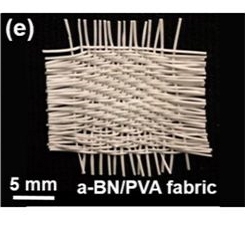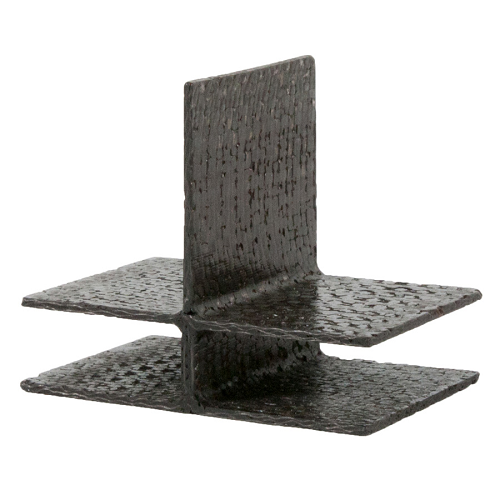I remember a long-term elementary school art project I participated in once that involved students weaving small bits of fabric together on a loom in order to make brightly colored textile objects that could only be described as ugly rugs for guinea pigs – that’s how little they were. I hated the tedious project, and hoped I would never have to hear about weaving ever again. I didn’t really, as it wasn’t a topic that came up often, until I first heard the term 3D weaving.
A weave is a pattern of intersecting warp and filling yarn; weaving, then, is the process of interlacing two kinds of of similar materials so they cross each other at right angles to produce woven fabric. 3D weaving works kind of like traditional 3D printing, and interlaces the material in layers to build a 3D textile object. One interesting method of 3D weaving, developed by Eindhoven Design Academy graduate Fransje Grimbere, coats a woven textile structure with resin to make a solid structure.
 Pennsylvania-based company Bally Ribbon Mills (BRM) designs, develops, and manufactures specialized engineered woven fabrics, tapes, webbing, preforms, and both 2D and 3D structural fabrics. The company has nearly 100 years of experience in textile manufacturing, and works with applications in multiple fields, including aerospace, automotive, commercial, defense, industrial, medical, and safety.
Pennsylvania-based company Bally Ribbon Mills (BRM) designs, develops, and manufactures specialized engineered woven fabrics, tapes, webbing, preforms, and both 2D and 3D structural fabrics. The company has nearly 100 years of experience in textile manufacturing, and works with applications in multiple fields, including aerospace, automotive, commercial, defense, industrial, medical, and safety.
Over the years, BRM has earned itself a well-deserved reputation for meeting difficult design challenges, including 3D continuous weaving. The company’s Advanced Products Group has developed the necessary technologies to fabricate complex 3D woven structures, like “Pi – π,” double “T,” “H,” and other net shapes.
“We make it a regular practice to take what was previously unattainable and make it a reality,” BRM says on its website. “If you’re looking for a new structure, or new ways to lower weight and cost without sacrificing integrity and performance, look no further than 3-D woven joints from Bally Ribbon Mills.”
This week, BRM has announced its new, unique film infusion capabilities for 3D woven joints, which can help its customers save processing steps. These complex 3D structures are mainly used in the aerospace field, and are custom made to fit the application – typically in airframe structural components and subassemblies, like joints and stiffeners.
 BRM’s new film infusion process works like this: the company infuses a frozen film or sheet of resin onto one of its custom 3D woven joints. It can do this with a variety of different resins, and the capability allows the company to ensure consistent quality control for its products, as it can control more of the steps of the 3D woven joint assembly manufacturing process.
BRM’s new film infusion process works like this: the company infuses a frozen film or sheet of resin onto one of its custom 3D woven joints. It can do this with a variety of different resins, and the capability allows the company to ensure consistent quality control for its products, as it can control more of the steps of the 3D woven joint assembly manufacturing process.
By developing this unique process, BRM’s customers won’t have to infuse the resin onto the 3D woven joints themselves once they’re delivered. By using film infusion, the company can actually ship its 3D woven joints as pre-made assemblies. By saving on processing steps that require specialized machinery, extra time, and work, customers can also enjoy extra cost savings as well.
One of BRM’s other capabilities is its 3D quasi-isotropical (0°, 90°, ±45°) near-net-shapes, which can be automatically woven using its computerized 3D Bias Loom.
Discuss this story and other 3D printing topics at 3DPrintBoard.com or share your thoughts in the comments below.
Subscribe to Our Email Newsletter
Stay up-to-date on all the latest news from the 3D printing industry and receive information and offers from third party vendors.
You May Also Like
Gorilla Sports GE’s First 3D Printed Titanium Cast
How do you help a gorilla with a broken arm? Sounds like the start of a bad joke a zookeeper might tell, but it’s an actual dilemma recently faced by...
Nylon 3D Printed Parts Made More Functional with Coatings & Colors
Parts 3D printed from polyamide (PA, Nylon) 12 using powder bed fusion (PBF) are a mainstay in the additive manufacturing (AM) industry. While post-finishing processes have improved the porosity of...
$25M to Back Sintavia’s Largest Expansion of Metal 3D Printing Capacity Since 2019
Sintavia, the digital manufacturing company specializing in mission-critical parts for strategic sectors, announced a $25 million investment to increase its production capacity, the largest expansion to its operations since 2019....
Velo3D Initiates Public Offering in a Bid to Strengthen Financial Foundations and Drive Future Growth
Velo3D (NYSE: VLD) has been among a number of publicly traded 3D printing firms that have attempted to weather the current macroeconomic climate. After posting a challenging financial report for 2023,...































